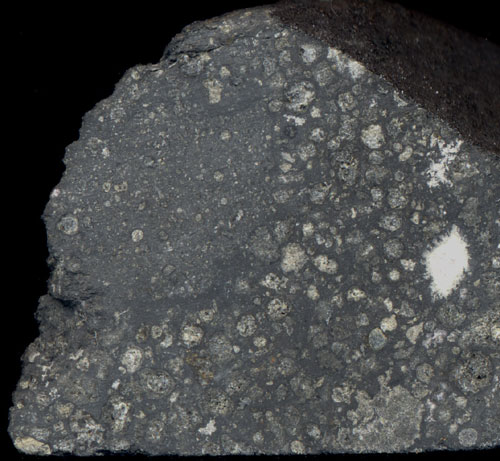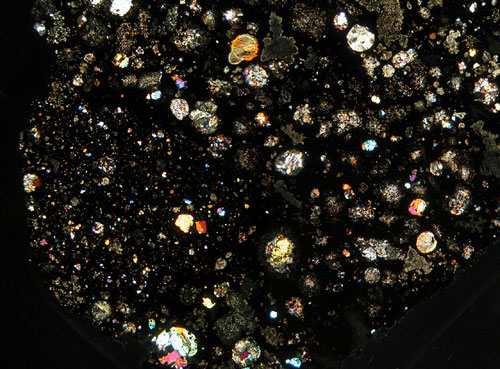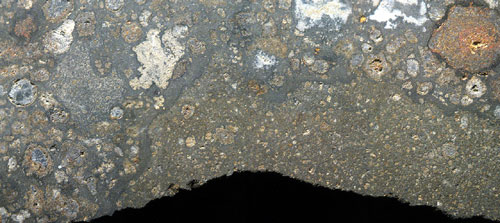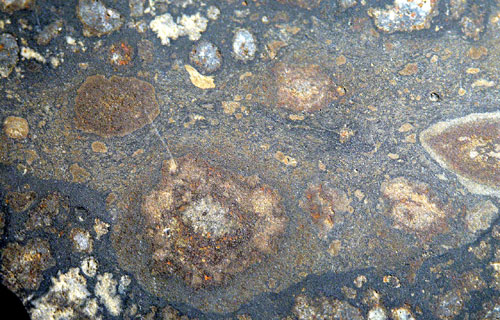


- Meteorites For Sale - Found A Meteorite? - Monthly Favourite - Meteorite Information - Classification List - Meteorite Collection - Media Centre - Home - Search - Site Map - Contact |
|
Dark Inclusions (DIs) Dark inclusions (DIs) have been found and reported in numerous carbonaceous chondrite groups but have been most prevalent and distinctive in the CV3 chondrites. The first meteorite to have this feature studied in considerable detail was the Allende (CV3) fall of 1969 which prompted them to be focused on more thoroughly in subsequent years. The information presented below is generally derived from studies on various CV3 chondrites. DIs have often been described as fine-grained xenoliths or lithic clasts and range in size from one millimetre to a few centimetres. They often appear to be considerably different to the host meteorite and their origin/formation has been the cause of some controversy. There are three kinds of Dark Inclusions that are found in the CV3 chondrites.
Type B: consists entirely of fine grains of iron-rich olivine, lacks chondrules and instead contains rounded porous aggregates of iron-rich olivine. Type C: consists mostly of fine grains of iron-rich olivine and are devoid of chondrules and porous aggregates. There are a few references towards Type A/B DIs which some regard as an intermediate between Types A and B. Despite the textural variations, DIs are similar in bulk chemical, oxygen isotopic and noble gas isotopic composition to their host CV3 chondrites. (Ohnishi/Tomeoka, 2002, Palme et al, 1989; Johnson et al, 1990; Bunch et al, 1980). However, there have been two main divisions in the origin of DIs. The first model infers that they are primary aggregates from the Solar Nebula while the second model suggests that they are actually fragments of the CV parent-body that were aqueously altered and subsequently dehydrated on the parent body (Ohnishi/Tomeoka, 2002, Kojima et al, 1993; Kojima & Tomeoka, 1996; Buchanan et al, 1997; Krot et al, 1997, 1998a,b, 1999). The most recent studies lean towards the second formation model. It is possible that the CV3 parent-bodies may not be as homogenous as previously thought and that they are rather a heterogeneous conglomerate of rocks, each of which has suffered different degrees of thermal and shock metamorphism.
While there are still various points of view regarding the formation of the somewhat enigmatic Dark Inclusions, it seems most recent studies have a relatively common formation model where the DIs are clasts which are thought to be genetically related to the host meteorite. DIs have been involved in aqueous alteration similar to the host meteorite but have undergone additional metamorphic events that the host meteorite did not. The DIs experienced thermal metamorphism and then later dehydration. The heat source for the thermal metamorphism is thought to be primarily from impacts at the CV parent-body surface although some heat from the decay of radionuclides can not be ruled out. Surface impacts also help to explain a couple of other points. The first being the large variation in shock and thermal metamorphism. As impacts occurred locally on the parent-body, it resulted in various extents of shock and thermal metamorphism. Consequently, the degree of shock and thermal metamorphism varied widely from location to location on the surface. Secondly, the impacts would also simultaneously cause brecciation and the intermixing of rocks from various locations in the parent-body. This would help explain the introduction of the DI's into the less metamorphosed host meteorite.
Return to Odds/Ends & Trivia home...
|
.jpg)
.jpg)
.jpg)



